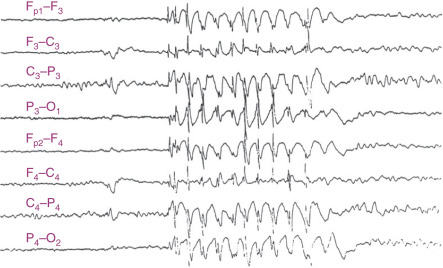Author: Naomi R. Kass, BA and Joseph S. Kass, MD, JD, FAAN



DefinitionAbsence seizures are a type of generalized seizure characterized by brief episodes of staring with impairment of consciousness (absence). They usually last no more than 20 to 30 sec. The onset and the end of the seizures are sudden. Patients are typically unaware of the seizure and resume the activity they were performing before the seizure. The electroencephalogram signature of absence seizures consists of a generalized 3-Hz spike and slow wave discharges.
Synonyms
- Childhood absence epilepsy
- Seizures, absence
| ICD-10CM CODE | | G40.309 | Generalized idiopathic epilepsy and epileptic syndromes, not intractable, without status epilepticus |
|
Epidemiology & DemographicsIncidence:1 to 10 cases per 100,000 population
Prevalence:Represents up to 12% to 18% of all pediatric epilepsy syndromes
Predominant Sex & Age:More common in girls than in boys, absences typically begin between 4 and 10 yr and remit by age 20 yr.1
Physical Findings & Clinical Presentation
- Patients with absence seizures usually have normal physical and neurologic examinations. However, attention deficit hyperactivity disorder (ADHD), anxiety, mood disorders, and learning disorders are common comorbidities in children with absence seizures.
- During the seizures, the patients are unresponsive and can have motor phenomena (automatisms, eye blinks, mouth and hand movements).
- Typical seizure duration is 4 to 20 sec.
- Absence seizures are not associated with post-ictal confusion.
- They may be triggered by hyperventilation associated with activity.
- Tonic clonic seizures are not usually a feature of this syndrome. If the patient also experiences tonic clonic seizures, other etiologies should be investigated, such as juvenile absence epilepsy, juvenile myoclonic epilepsy, complex partial seizures, etc.

The medication of choice based on the best current evidence available is ethosuximide, followed by valproic acid and lamotrigine.2
Nonpharmacologic TherapyNot applicable
Acute General Rx
- Ethosuximide: Initial dose: 5 to 10 mg/kg/day divided into two doses for children <6 yr and 250 mg/kg twice daily for children 6 yr and older; then after 7 days, the usual maintenance dose is 15 to 40 mg/kg/day in divided doses; goal therapeutic concentration is 40 to 100 micrograms/ml.
- Divalproex sodium (Depakote): Initial dose: 15 mg/kg/day (divided od, bid, or tid); dose is increased by 5 to 10 mg/kg per day at weekly intervals until seizures controlled or side effects prevent further increases; maximum/maintenance dose: 30 to 60 mg/kg/day (divided bid or tid); therapeutic concentration is 50 to 125 micrograms/ml.
- Lamotrigine (Lamictal): Dose for patients age 2.5 to 13 yr on no other antiepileptic drugs. Wk 1 and 2: 0.3 mg/kg/day. Wk 3 and 4: 0.6 mg/kg/day. Wk 5 onward: Increase every 1 to 2 wk by 0.6 mg/kg/day. Maintenance: 4.5 to 7.5 mg/kg/day. Warning: Should be used with caution due to the potential for toxicity and Stevens-Johnson syndrome. Patients on other antiepileptic drugs can also have severe adverse reactions (e.g., valproate can cause increased levels of lamotrigine, and lamotrigine must be titrated much more slowly in patients on valproate therapy).
Chronic Rx
- Children with recurrent seizures require chronic treatment.
- If children are seizure-free for a period of 1 to 2 yr, a trial on no medications should be considered; children typically outgrow childhood absence seizures.
Disposition
- Response to treatment is excellent.
- Absence seizures tend to remit in teenage years.
- Epilepsy can be considered as resolved once 10 yr have elapsed since the last event, including 5 yr free from medications.
Complementary & Alternative MedicineNot applicable
ReferralPatients with epilepsy should be referred for a consultation by a child neurologist, preferably one specializing in epilepsy.
